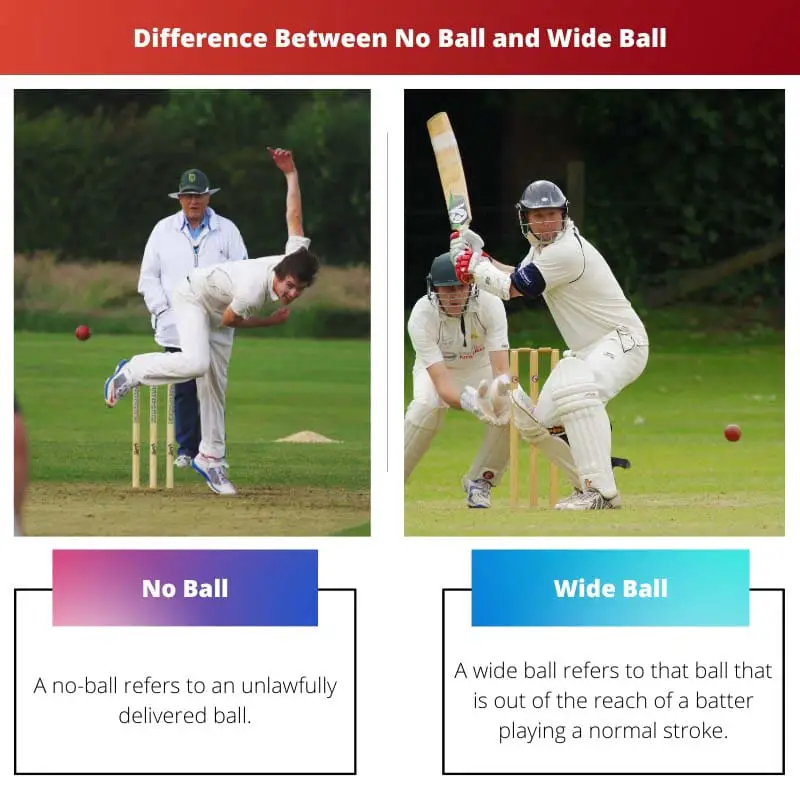Cricket is one of the most popular sports worldwide. Like any other sport, there are different terminologies used in a cricket match that may be confusing for some. A no-ball and a wide ball are two common occurrences in all cricket matches.
While they may seem identical, there are considerable differences between a no-ball and a wide ball.
Key Takeaways
- No ball is a type of delivery in cricket that is considered illegal, because the bowler oversteps the crease or the ball is not delivered within the game’s rules. In contrast, a wide ball is a legal delivery outside the batsman’s reach.
- A no-ball results in a free hit for the batting team, while a wide ball adds an extra run to the batting team’s score.
- A no ball can result from various factors, such as the bowler’s foot placement or the arm’s position during delivery, while a wide ball is caused by the ball being too far away from the batter.
No Ball vs Wide Ball
A no ball is a delivery in cricket that does not count as one of the six legal deliveries bowled in an over. A wide ball is an illegal delivery where either part passes wide outside off-stump and can’t be reached by the batsman with their normal stance and swing of their bat hence, illegal.

A no-ball refers to an unlawfully delivered ball. Usually, there are 16 types of no balls. For instance, a ball that bounces more than twice can be declared as a no-ball.
The main aim of the consequences of different types of no-ball is to ensure that the baller doesn’t gain any advantage from this action and the interests of the batsman are protected.
A wide ball refers to that ball that is out of the reach of a batter playing a normal stroke. The usual distance of a wide ball from the middle stump is around 3 feet in length on either side of the stumps.
The usual consequence of a wide ball is an extra run added to the batting team’s scorecard. There are no serious side effects of a wide ball for the bowler.
Comparison Table
| Parameters of Comparison | No ball | Wide Ball |
|---|---|---|
| Seriousness | No-ball is a more serious offence than a wide ball. | A wide ball is a less serious offense than a no-ball. |
| Scoring notation | The scoring notation is a circle. | The scoring notation of a wide ball is an equal cross. |
| Consequence | The consequence of a no-ball can be an extra run or a free hit or suspension of the bowler under serious circumstances. | The consequence of a wide ball is an extra run to the batting team. |
| Occurrences | Common occurrences of a no-ball are bouncer, beamer, and deliberate overstepping respectively. | A wide ball occurs when the ball is at a distance of around 3 feet from the middle stump. |
| Next Step | A no-ball is accompanied by a free hit. | A wide ball is accompanied by an extra run. |
What is No Ball?
No ball refers to an illegal delivery in cricket to a batter. Usually, the consequence of no-ball is an extra run awarded to the opposing team.
However, some regulations may suggest two extra runs as a consequence of no-ball. In addition, another ball must be bowled. Furthermore, the number of ways a batter can be declared out reduces to three.
In smaller games, a no-ball is accompanied by a free hit. A free hit means the batter can freely hit the ball without any danger of being out. In most cases, no ball is a more common occurrence by fast bowlers than by slow ballers.
In short form cricket, the most common instances of no-ball are a result of crossing the crease by the bowler.
In situations when the back foot of the bowler either land on the touching or the wide of the return crease, it is a no-ball. An umpire may classify a ball as a no-ball when it is dangerous or unfair.
For instance, fast short-pitched delivery or a high full pitched delivery or a deliberate front foot fault is classified as a no-ball. Common names of these balls are bouncer, beamer, and deliberate overstepping respectively.
A no-ball is not included in the six deliveries of an over. There are several different causes and consequences of a no-ball.
While the most common causes have already been discussed, the consequences of no-ball may range from a free hit to extra runs to the batting team to immediate suspension of the bowler in instances of a dangerous delivery.
What is a Wide Ball?
A wide ball is a ball that is not sufficiently within the reach of the batter.
The main condition to be satisfied to classify a ball as a wide ball is that it can not be hit with the bat via a normal cricket stroke from the present position of the batter or for when the batter is standing in a normal guard position.
Law 22 of the Laws of Cricket covers the concept of the wide ball.
Thus, the definition of a wide ball implies that any ball which is not within the reach of the batter solely because he changes his position by moving would not be categorized as a wide ball.
Usually, when a wide ball is played, an extra point is accorded to the team. However, this point isn’t added to the scorecard of the particular batter.
A wide ball is classified as an additional delivery. It is not included among the six deliveries of an over. The main fault of a wide ball is of the bowler.
While such an action has no serious repercussions, it is added to the bowler bowling analysis.
When the sport of cricket initially began, the instances of a wide ball were relatively fewer.
However, with the increasing popularity of the sport, there has been a stricter implementation of rules and regulations to ensure fair competition between opposing teams. Consequently, the instances of a wide ball have risen over the years.
Main Differences Between No Ball and Wide Ball
- No ball is covered under law 21 of cricket. In contrast, a wide ball is covered under law 22 of cricket.
- While a no-ball refers to an illegal delivery to the batter. On the other hand, a wide ball is a ball that surpasses the batter’s normal stroke.
- While a free hit may be given for a no-ball, there is no such consequence of a wide ball.
- An umpire indicates a no-ball by raising his one arm at shoulder height. In contrast, an umpire indicates a wide ball by raising both his arms at shoulder height.
- When a ball delivery is classified as both a no-ball and wide ball, it is declared as a no-ball.

- https://en.wikipedia.org/wiki/Wide_(cricket)#:~:text=8%20References-,Definition,of%20the%20Laws%20of%20Cricket.&text=Therefore%20a%20delivery%20is%20not,ball%2C%20and%20not%20a%20wide.
- https://en.wikipedia.org/wiki/No-ball#Causes
